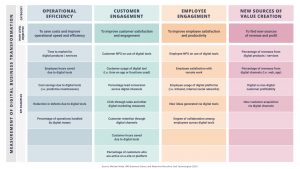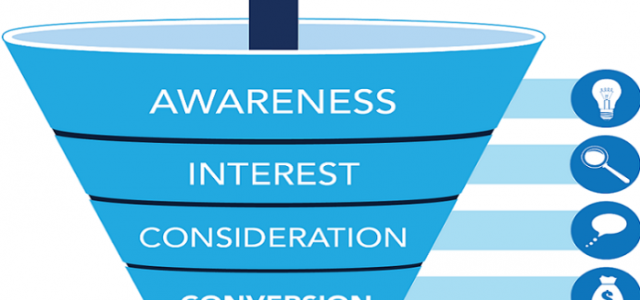Peter Drucker’s mantra – You can’t manage what you don’t measure – applies as much to digital transformation as it does to any other business context. Yet, digital transformation provides a number of additional challenges. In some areas, such as digital marketing, there is a plethora of metrics and the challenge is to identify the right ones to meet your needs. In most other areas, however, effective metrics are still emerging. The reality for many executives today is that they only have a vague sense of how well their digital transformations are going. Thus, it is no wonder that 87% of digital transformation projects fail to reach their pre-defined objectives.
Many managers we have spoken to have relied on relatively generic KPIs (key performance indicators), such as adoption rates of new digital tools, but failed to evaluate whether or not tangible business performance impacts had been generated. According to a 2020 study by BCG, only two out of five organizations created measures to link digital tools and technologies to business impacts. It further found that those that did so were much more likely to be associated with winning transformation programs.
Many digital projects are inherently complex as they require a lot of cross-functional coordination, yet they are often subject to the same business case processes as standard IT projects. Indeed, a 2020 study by consulting firm Gartner showed that almost 50% of organizations had no specific metrics in place to measure digital success. As a result, digital projects are often regarded as failures simply because they were set up with false or unrealistic expectations.
Begin with clear objectives
The accomplishment of digital initiatives is often defined using poor proxies of the desired objective. For example, the success of an app is frequently measured by downloads (“the more an app is downloaded, the more successful it is”). However, many apps are downloaded but rarely used: to be consistent with a clear objective, actual app usage would be a far better KPI.
A well-defined objective must be in a measurable format. For example, Cisco’s objective for digital transformation between 2015 and 2020 was 40/40/2020, where 40% of total company revenue would come from recurring sources, and 40% would come from software by the end of 2020. In Cisco’s case, it became necessary to create a clear distinction between revenues that were accrued from one-time-sales of products or services, such as a piece of networking equipment, and revenues that came from the sale of subscriptions, such as a renewable video conferencing licence. Similarly, the company needed to clearly differentiate between software and hardware products and allocate the revenues of each separately, even in cases where they were bundled into a single offering.
Divide digital measures into categories
We suggest dividing measures into four categories that directly link to how digital solutions can positively impact business performance (See Table 1). They are:
- Operational efficiency, or reduction of costs through improved operational speed and efficiency
- Customer engagement, or improvement in customer satisfaction and interactivity
- Employee engagement, or improvement in employee satisfaction and productivity
- New value creation, or creation of new sources of revenue and profit
Operational efficiency
Measurements within the operational efficiency category are concerned largely with the use of digital tools and technologies to increase speed and reduce costs. While objectives in this category may not look as exciting as those that are customer-facing or linked with new sources of value creation, they can nevertheless add a lot of value. For example, digital tools such as predictive and preventative maintenance systems can significantly reduce defects and save costs due to unnecessary equipment shutdowns. According to the U.S. Department of Energy, predictive maintenance programs can result in a 25% – 30% reduction in maintenance costs and a 35% – 45% reduction in downtime.
Cost-saving opportunities can be particularly relevant in the public sector. SMRT, the Singapore public transport network, utilizes a reporting channel called Snap-Rep, which allows passengers to signal faults by sending a WhatsApp message. SMRT trains have an average car occupancy of 55 and a yearly ridership of 753 million: digital solutions have allowed this to be easily leveraged, even if commuters do not have the skills of a professional maintenance team.
Other tools can reduce time to market for products and services by removing processes and other steps in a value chain. When UK hospitality giant Mitchells & Butlers incorporated automation into how it handled paperwork, for instance, it was able to save more than 20,000 employee hours and more than 3 million pieces of paper. It also found itself able to identify errors much sooner than when everything was manual.
Customer engagement
Perhaps the most mature area of measurement can be found within digital marketing, largely due to the rise in social media as an alternate channel for engaging with customers. These KPIs seek to assess the effectiveness across different stages of a customer journey, from awareness of product or service to a specific action, such as clicking through to website, to eventual purchase, adoption, and finally repurchase and advocacy. Some indicators have become fundamental parts of digital marketers’ toolkits, including traffic measurement, impressions, click-through rates, conversion rates, drop-offs, mentions, reposts, churn, and so on.
Beyond digital marketing tools, measures can be used to evaluate customer satisfaction through pulse surveys or NPS scores. Customer activity can be assessed on a site or platform to ensure that the attention of customers is being captured effectively. Another way that customer engagement can be measured is by time saved. Netflix, Uber, Amazon, and other digital giants have effectively saved time by automating the process of watching movies, ordering transportation, and shopping. These time savings can be measured, such as the time it takes to find an answer to a question through an intelligent agent versus a call center.
Singapore-based bank DBS developed the “customer hours” concept, which has since been adopted by other digital frontrunners, including Google. The concept of customer hours – a unit of wait time for a customer (for example, a customer waiting for a credit card for an hour equals one customer hour) was born out of a desire to make the customer’s life better. While the bank initially hoped to take 10 million customers hours out of the bank, it ended up taking out 250 million hours. It also helped generate a shared sense of purpose amongst DBS employees.
Employee engagement
Digital tools are increasingly used to improve employee engagement, to the extent that they are becoming a pillar of talent acquisition strategies. These tools can be utilized in different contexts (training of new hires, everyday work, special projects etc.), therefore the spectrum ranges from intranets and other internal communication platforms to AR solutions, robotics and more.
The COVID-19 pandemic accelerated the usage of such tools, since physical contact was no longer available as before.
KPIs to assess whether digital tools are functioning well could include a number of tasks that have become automated, such as revenue generation per employee, reduction of errors, and so on. It is important to measure tool adoption and usage, including how many employees are regularly accessing a tool, whether they are using all the features of the tool, and what the total saved time is thanks to usage. For example, McDonalds introduced gamification into their employee training process for till-training exercises. Employees reported having a better understanding of the new system, and the corporation saw improved employee performance and engagement, as well as an increase in average order value.
New value creation
In addition to operational efficiency and customer and employee engagement, it is important to ascertain whether digital tools and technologies have a positive impact on revenue and profitability through new forms of value creation.
Value creation may come from innovative products, services, or business models, that can open totally new perspectives. In Southeast Asia, Grab was founded with the objective to offer better ride services: while GrabInsure was a relatively obvious addition to the portfolio, GrabDurian met specific requirements related to very peculiar transportation constraints. Examples of KPIs include percentage of revenues and profits that come from new digital products and services.
Many organizations are offering their products and services through new channels, such as own-brand eCommerce, online marketplaces, and apps. If AutoScout24 (the largest pan-European online car market) has more than 30 million users per month, automotive companies should assess the performance of such a platform – hence, customer acquisition via this channel would be a reasonable KPI.
Create a visual digital scorecard
It is not only important to develop individual measures of success. These indicators can be rolled up to provide an overall assessment of performance based on the objectives set up in advance of the digital transformation. For example, Cisco might have dozens of measures to evaluate its recurring revenue and software targets across R&D (i.e. new product development) to manufacturing (i.e. production targets) to marketing (i.e. awareness targets) to sales (i.e. revenue and profitability targets). Only once these measures have been consolidated would it be possible to assess whether the 40/40/2020 target had been met.
The algorithm or scorecard used to consolidate the measures into an omnibus assessment of digital transformation success needs to be determined individually by each organization. We recommend that KPIs are collected in as close to real-time as possible and presented in the form of a visual dashboard. Dashboards can be created from almost all databases and data analytics tools. When Danish sportswear company Hummel decided to put omnichannel retailing at the core of its digital transformation, it was faced with the challenge of keeping track of various indicators across different sales channels. It responded to this challenge by creating a customized, real-time dashboard tracking indicators such as follower counts across various social media platforms, unique page views and visits, eCommerce transactions, etc. The most effective dashboards are visually appealing, up-to-date, and configurable so that each manager can modify the dashboard to fit his or her particular needs.
Measure to survive
Digital disruption is reflected in a dramatic reduction in corporate longevity – even before the COVID-19 pandemic, the average tenure of companies on the S&P 500 fell from 33 years in 1964 to 24 by 2016, and is forecast to shrink to just 12 years by 2027. The music industry, for example, has been in the hands of few global organizations for decades, but new players have taken very little time to completely change the game – today, in 42 markets, overall digital revenues account for more than 50% of the recorded music market. Dell Technologies surveyed 4,300 business leaders from around the globe: almost 1 in 3 are worried their organization will not survive the next couple of years.
Under such circumstances, the ability to manage digital transformation is paramount. A key contributor to transformation success is the ability to assess the performance of digital initiatives. Unfortunately, the KPIs to measure digital performance have not kept pace with the technologies themselves. Most organizations need to review, rethink, and upgrade how they measure various aspects of their digital transformations.
Table 1:
Examples of digital success measures across four categories

Written by Michael Wade, Professor of Innovation and Strategy at IMD Business School, and Massimo Marcolivio, Marketing Manager B2B at Dell Technologies
1 Wade, Michael and Shan, Jialu (2020) “Covid-19 Has Accelerated Digital Transformation, but May Have Made it Harder Not Easier,” MIS Quarterly Executive: Vol. 19 : Iss. 3 , Article 7.
Available at: https://aisel.aisnet.org/misqe/vol19/iss3/7
2 Forth, P., Reichert, T., de Laubier, R., Chakraborty, S. (2020). Flipping the Odds of Digital Transformation Success. Boston Consulting Group. https://www.bcg.com/publications/2020/increasing-odds-of-success-in-digital-transformation
3 Moore, S. (2019). How to Measure Digital Transformation Progress. Gartner. https://www.gartner.com/smarterwithgartner/how-to-measure-digital-transformation-progress/
4 U.S. Department of Energy, 2013. https://www1.eere.energy.gov/femp/pdfs/OM_5.pdf
5 SMRT Corporation, https://www.smrt.com.sg/SNAP-REP
6 Duguid, R. (2018). How Automation Is Transforming the Supply Chain Process . Manufacturing.net. https://www.manufacturing.net/automation/article/13245800/how-automation-is-transforming-the-supply-chain-process
7 Gregory, S. (2019). 19 Important Digital Marketing Metrics for Measuring Success . FreshSparks. https://freshsparks.com/digital-marketing-success/
8 Sia, S. K., Soh, C., & Weill, P. (2016). How DBS Bank Pursued a Digital Business Strategy. MIS Quarterly Executive, 15(2).
9 Profiles (2020). How to use digital learning to increase employee engagement. Profiles Asia Pacific. https://www.profilesasiapacific.com/2020/05/05/digital-learning-employee-engagement/
10 Grab (2020), https://www.grab.com/sg/brand-story/, https://www.grab.com/sg/insurance/, https://www.grab.com/sg/grabdurian/
11 AutoScout24 (2020), https://www.autoscout24.com/company/about-autoscout24/company-profile/portrait/
12 Hansen, R., & Sia, S. K. (2015). Hummel’s Digital Transformation Toward Omnichannel Retailing: Key Lessons Learned. MIS Quarterly Executive, 14(2).
13 Innosight (2018), 2018 Corporate Longevity Forecast: Creative Destruction is Accelerating, https://www.innosight.com/insight/creative-destruction/
14 IFPI (2020), https://www.ifpi.org/our-industry/industry-data/
15 Dell Technologies (2020), Digital Transformation Index 2020, https://www.delltechnologies.com/en-us/perspectives/digital-transformation-index.htm#scroll=off
Michael Wade, along with co-authors Didier Bonnet, Tomoko Yokoi, and Nikolaus Obwegeser will publish Hacking Digital: Best Practices to Implement and Accelerate Your Business Transformation with McGraw-Hill in September 2021.
Article by channel:
Everything you need to know about Digital Transformation
The best articles, news and events direct to your inbox
Read more articles tagged: Featured, Measurement & KPIs






